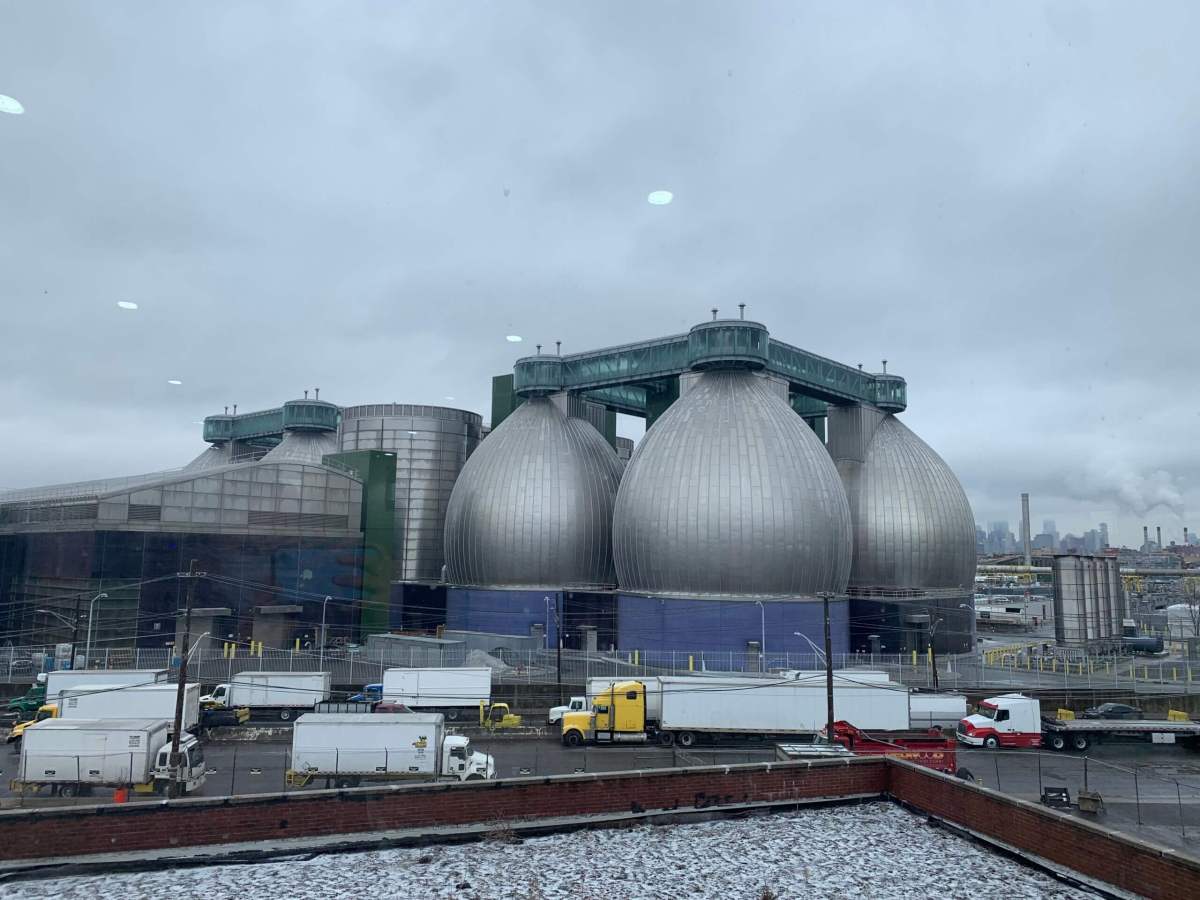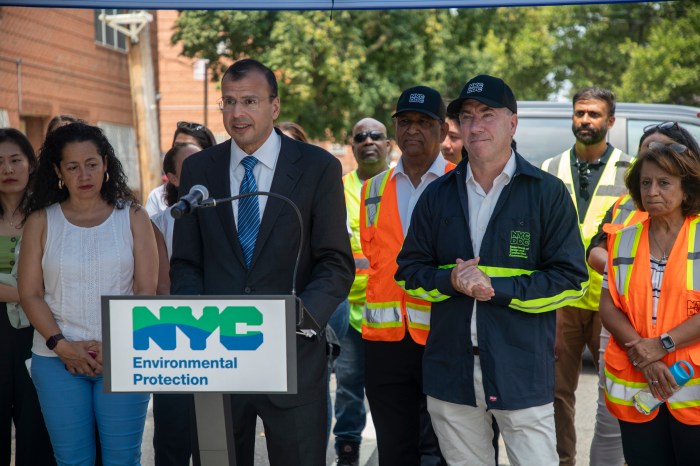A first-of-its-kind renewable energy project in Greenpoint has become a point of contention between the community, the city, and utility giant National Grid.
The renewable-biogas-to-grid project at the Newtown Creek Wastewater Treatment Plant — a partnership between the city’s Department of Environmental Protection and National Grid — has been touted as an “innovative project” that would reduce carbon emissions and save local National Grid customers some cash.
But years of delays, equipment issues, and new questions about the financials of the project – and how it will really impact ratepayers – have left local environmentalists frustrated at best.
Biogas and the grid
The partnership was first announced over a decade ago, during the Bloomberg administration.
Eight massive “digester eggs” at the Wastewater Treatment Plant to process at least 250 million gallons of wastewater and 220 tons of organic waste each day, according to the DEP, which operates the plant. The eggs turn the waste into a refined “slurry” used for composting. A byproduct of that process is biogas — a form of natural gas composed mostly of methane.
DEP uses about 40% of that biogas to power the treatment plant, and, with the new gas-to-grid project, the remaining 60% is given to National Grid for free to be refined and added to the company’s supply.
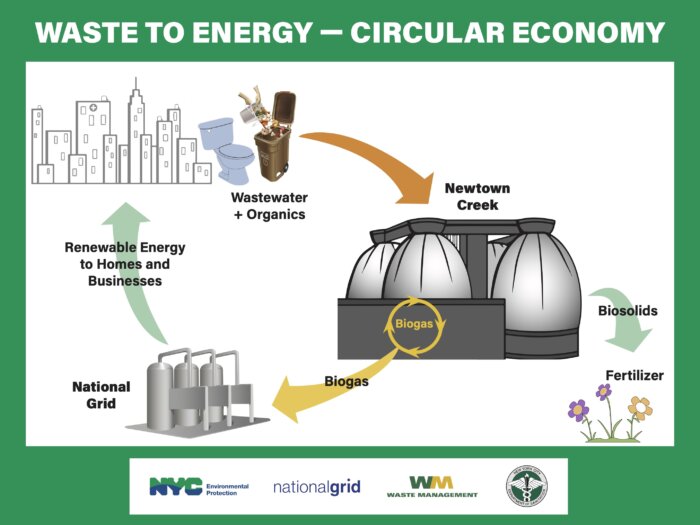
According to DEP and National Grid, at max capacity the plant produces enough biogas to heat 5,200 homes, and keeps 90,000 metric tons of greenhouse gas out of the atmosphere each year.
Before the project came online, DEP would “flare,” or burn off, the excess gas. The partnership with National Grid was set to launch in 2015 — but didn’t actually come online until March 2023, to the consternation of the community.
City officials “cut the ribbon” on the project three months later, last June, and said that with National Grid’s involvement, “essentially 100 percent of the biogas” would be put to good use, reducing carbon emissions and cutting back on flaring.
A $70 million project goes down after five months in operation
However, in August, Greenpoint residents noticed that National Grid’s flare was lit — indicating that the gas-to-grid system was offline after just five months in service.
The company did not tell locals the system was down, multiple people said at a recent Community Board 1 meeting where National Grid and DEP gave updates about the project.
At that meeting, National Grid officials first indicated that the system had tripped offline in August but had been working consistently at about 75% capacity since then – but, after prompting from community members, said the system had been down for a few months after the August shutdown, and had been taken offline for shorter spans several times since then.
Karen Young, a National Grid spokesperson, told Brooklyn Paper that the gas-to-grid system was down for 10 weeks between August and November, and that there have been “other trips and occasions when we’ve taken the system offline for much shorter periods for assessment and testing.”
As of Jan. 31, the project was up and running at 75% capacity, Young said, as the company conducts “analysis, calibration and adjustments.” National Grid expects to make those tweaks and return to full capacity within the next two months, she added.
“Why not be transparent? This is so frustrating,” said Willis Elkins, executive director of the Newtown Creek Alliance, at the meeting. “Please be transparent about the realities here and don’t give us the couple good highlights.”
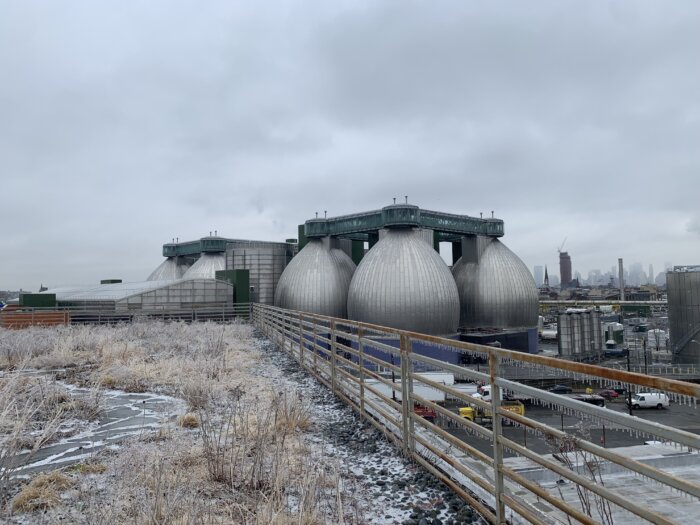
National Grid operates one flare, a thermal oxidizer, while DEP has four. When the National Grid system is down, and there is too much gas for DEP to handle on its own, the agency burns off the extra gas.
Elkins later told Brooklyn Paper that locals often only know the flares are on because they spot the flame themselves — there is no official system to inform Greenpointers when the system is down.
Beth DeFalco, deputy commissioner of public affairs and communications at DEP, said the agency and National Grid are working on a system to share the real-time status of the gas-to-grid network, “so we don’t have to rely just on Willis or the community to understand what the status of it is.”
However, Elkins said, the flare sometimes causes a more alarming phenomenon — vibrations on the streets and in the buildings around the treatment plant. Standing on the street, he said, it feels like a “deep rumbling” — and inside NCA headquarters just across the street from the digester eggs, the windows visibly shake.
“It’s like a Jurassic Park glass of water thing,” he said. “It goes for 30 seconds to a minute, it’s very intense.”
In August, when the system went down, the vibrations were frequent and intense, he said, and neighboring businesses have expressed concerns that it will damage the structural integrity of their buildings.
“They’ve all had a lot of concerns, but we haven’t gotten a lot of positive response from the city about it because it’s a very unique thing,” Elkins said. “If you complaint to 311 about something like this, they say ‘That sounds like an issue for DEP’ … and it’s like, no, this issue is with the agency.”
A first-of-its-kind system
By the time the gas-to-grid system came online last March, Greenpointers had built up years of frustration toward the project — and learning that it was malfunctioning, leading to gas being burned off anyway, hasn’t changed those feelings.
Brendan Hannon, a city research scientist at DEP, said that the gas created at Newtown Creek does not technically add to levels of carbon in the atmosphere.
“This is a carbon that was sitting underground three years ago pumped up and turned into natural gas,” he said. “This is carbon that was a plant, before it was a plant it was in the atmosphere, we’re cycling through quickly.”
However, both National Grid and DEP officials stressed that the project is the first of its kind in the entire country.
“We got out ahead of this really early, and we learned a lot through this process,” Connelly said. “We’ve learned a lot about the future and how we would do this again and how we would do it differently in the future so we can speed to success.”
The gas-to-grid project was first conceptualized as a “demonstration project,” said Donald Chahbazpour, director of regulatory and policy strategy at National Grid.
“The way we are doing it at a demonstration project, it’s really intended to lower costs that all of us pay,” he said. “Everyone, when you’re paying your utility bill, has a return on this project.”
Rate payers pick up the cost
However, while National Grid receives the gas from DEP for free, and will for the next 19 years — the city’s contract with the utility granted gas for free for 20 years starting once the project came online — the company is still seeking to recoup the $70 million they spent on the facility.
That means the gas-to-grid project won’t bring bills down in Brooklyn, at least not any time soon.
Part of the cost of the project was included in National Grid’s last rate hike, Young said, which saw some customer bills rise by an average of $66 per year. The rest is included in a new proposed rate case, which would raise customer bills by an average of $30 per month.
National Grid plans to offset some of the cost of the project by selling biogas produced at the facility — and by selling environmental attribute credits through the federal Environmental Protection Agency’s Renewable Fuel Standard Program.
National Grid receives “credits” for generating renewable fuel and then sells those credits, separately from the fuel itself, to other companies.
“Basically what it means is, if I’m in California and I’m a fuel producer and my fuel produces greenhouse gasses, and I have to comply with some regulation, I can either reduce my emissions or I can buy an environmental credit from New York, where someone else has reduced emissions,” explained a source familiar with National Grid’s pending rate case.
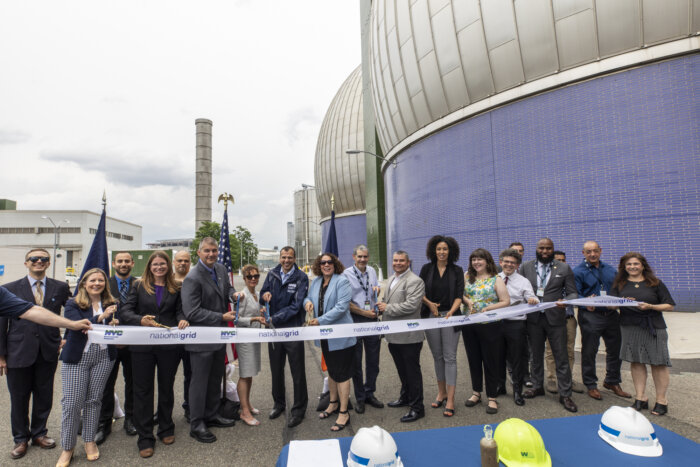
According to the 2021 rate case decision, National Grid expected the gas-to-grid project at Newtown Creek to generate roughly $9 million in revenue from the sale of gas and credits over the course of three years.
The gas generated at the treatment plant — even at full capacity — can only meet the needs of a fraction of National Grid’s customers in Brooklyn, Chahbazpour said.
“When you look at the number of homes a year and the amount of gas demand a year, it will literally be a grain of sand in terms of the supply that’s being used in Brooklyn,” he added.
Elkins said he recognizes the ecological value of using the city’s organic waste in new ways and keeping it out of landfill – but that the city’s choice to give gas for free National Grid — who in turn monetize the project while still investing in fossil fuel projects – is a “huge complication.”
Kevin LaCherra, a longtime Greenpointer, said at the meeting that National Grid had come before the community many times, promising the project would be up and running soon through years of delay.
“And then your own guy is saying it’s a grain of sand, it’s a drop in the ocean, it’s infinitesimal compared to what we’re actually talking about here, which is that you’re investing in the same technology that is killing us and drowning us,” he said. “This is so small, and it is taking you so long.”


